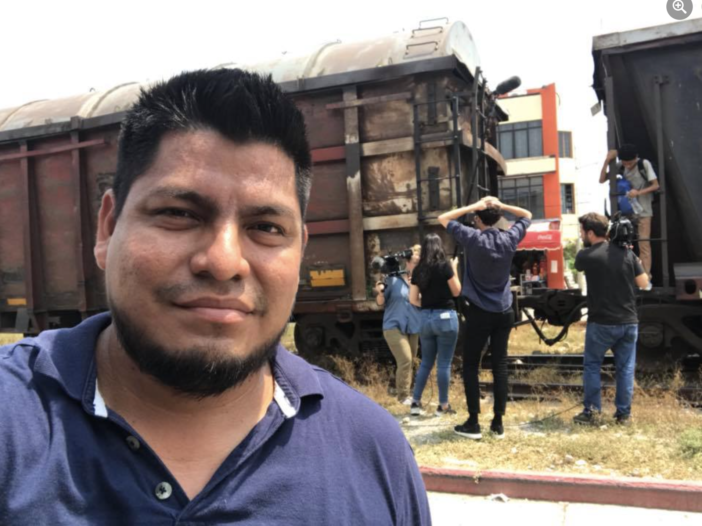Vania Pigeonutt
Benjamín Alfaro has been a multimedia journalist in southern Mexico since 2005. He grew up in Tapachula, Chiapas, a city very close to the border with Guatemala, a turnstile on the route of migrants from Central America and people who travel from all over the world with the dream of reaching the United states.
Every time a team of journalists looks for a local fixer or producer in Tapachula, Benjamín’s name comes up. He’s highly recommended because he knows very well the southern border corridor that encompasses Chahuites, Oaxaca, Tapachula, Chiapas, Tenosique, Tabasco, and even Guatemala. He considers himself part of the border community, and has built alliances with “acquaintances, braceros, the person at the little store, with colleagues in local media in Guatemala, and others.”
Bejamín has been part of award-winning international productions. His job is to be aware of the local and international contexts, and make alliances with colleagues. With 16 years working as a fixer and local producer, he has managed to secure fair remuneration and credits in the news stories that get published.
But it was not always like this. The first time a German public television station called him in 2008 to work as a fixer, he thought it was a scam. They were going to pay him 2,500 pesos a day; and in four days he would earn more than what he earned all month at the local media where he was a reporter and cameraman. Despite his reservations, he accepted. He took vacation days from his other job and did well in his first fixer experience.
Later on he began to have some less fortunate experiences.
“I have experienced that the U.S. media outlet media wants to cheapen my work, even foundations, which have a budget for everything: for coordinators, plane tickets, meals, hotels and transportation. But in the end they only leave a tiny fee for the fixer; the fixer gets whatever is left over. These are foundations that highlight the rights of certain people but violate the labor rights of the fixer,” says Benjamín.
His worst experience was when he worked for a Spanish media outlet that ended up charging him.
“We were in Tapachula. And in the end, the interview that the media had agreed to fell through. And they fined me 20 dollars. I didn’t say anything because I didn’t know how this worked, neither did I know that they could fine me because an interview that they themselves had booked fell through,” he recalls.
Over time he has learned how to avoid these slights and violations of his labor rights. He does not think it is fair that journalists in the northern border with the United States can charge more when he also runs as many risks; but he recognizes that there is not much he can do about this disparity.
“As a journalist, I always prioritize that they respect me and my work. I like to get in return the same professionalism with which I share my knowledge and my work. And not only toward me, but also toward the sources we interview.” Benjamin says.
He worries about how some foreign journalists treat the people they interview. Many of these sources are people in vulnerable conditions who travel in migratory caravans or who have been detained by authorities along their journey.
“Reporters present themselves as company employees. They understand themselves as a business, as an authority, and not as a human being. It is difficult for them to create bonds with people. They do not question themselves in order to understand the story with empathy, but rather they want to extract certain answers to look good with their outlet,” he says.
Due to the dangerous conditions for journalists in Mexico, Benjamín says it is necessary to know where risk lies. He says that if someone contacts him for a risky assignment, it’s best to let it go because in the end it can be more costly.
“We must understand that in risk areas, fixers are not the only ones who are in danger, sources too. You are the one who finds a source and explains to the reporter what is happening; you are also the one who gets the visual resources. It is necessary to have professionalism, because then they lie to give their work greater visibility. You fall into that trap of being sensationalist and alarmist,” he says.
He mentions that at times he has opted for anonymity, as he believes it is safer for him.
“In terms of violence in the region, it’s until now that Chiapas has its conflict zone. I avoid going there. Many times I have practiced self-censorship to protect myself. I have remained anonymous many times. Not wanting to take credit is also a security measure,” he says.
He’s concerned by the normalization of violence against journalists, since it is common for a communicator to be murdered and for this colleague’s death to receive, if any, very little news coverage.
“Violence is on the rise. It is due to society normalizing certain prejudices; they justify or blame the attacks by saying ‘why do they get involved?’ or ‘they shouldn’t get involved in those things,'” he says.
He compares the situation of journalists working in small towns with that of teachers in rural areas, where both lack the necessary conditions and tools to do their job but are blamed for not doing it well, and people believe all the lies about them shared on social networks.
Benjamin emphasizes the same saying that colleagues use in other dangerous places: “a story is not worth your life.”
Furthermore, he recognizes the value of belonging to his family and community, and of contributing to society with his journalism.
We are fathers, husbands, wives, mothers, children and members of a community. If we, the reporters who walk the streets, are no longer here, who will document these stories? These images and stories will only be dust in the wind.”




